Abstract
To investigate the mechanisms which enable the diaphragm to preserve ventilation when the work of breathing is elevated, we measured diaphragmatic blood flow (Q di) and oxygen consumption (VO2 di) in lightly anesthetized dogs. The animals were studied when they breathed quietly, when they inhaled 5% CO2 in 21% or 14% O2, or when they inhaled these gas mixtures through moderate to severe inspiratory resistances. Q di was determined from the integrated diaphragmatic arteriovenous difference of krypton-85, by the Kety-Schmidt technique. VO2 di was calculated as the product of Q di and the diaphragmatic arteriovenous oxygen difference ([A-V]O2 di). Alteration in these parameters consequent to augmentation of ventilatory effort were compared with concomitant alterations in diaphragmatic electrical activity (EMG di) and an inspiratory pleural pressure-time index (PPTI). Addition of inspiratory resistances combined with inhalation of CO2 usually increased Q di and consistently increased VO2 di, EMG di, and PPTI, the maximum increases being approximately 400-1,600% above control levels. In individual animals, as inspiratory resistance was increased, VO2 di, EMG di, and PPTI rose in direct proportion to each other. In the group as a whole, during resistance breathing the oxygen requirements of the diaphragm were met by a combination of increased [A-V]O2 di and Q di. Unlike other skeletal muscles, oxygen extraction tended to plateau at peak loads, whereas blood flow continued to rise as PPTI and VO2 di increased. We conclude that augmentation of perfusion permits the diaphragm to sustain high levels of contractile effort when the work of breathing is increased.
Full text
PDF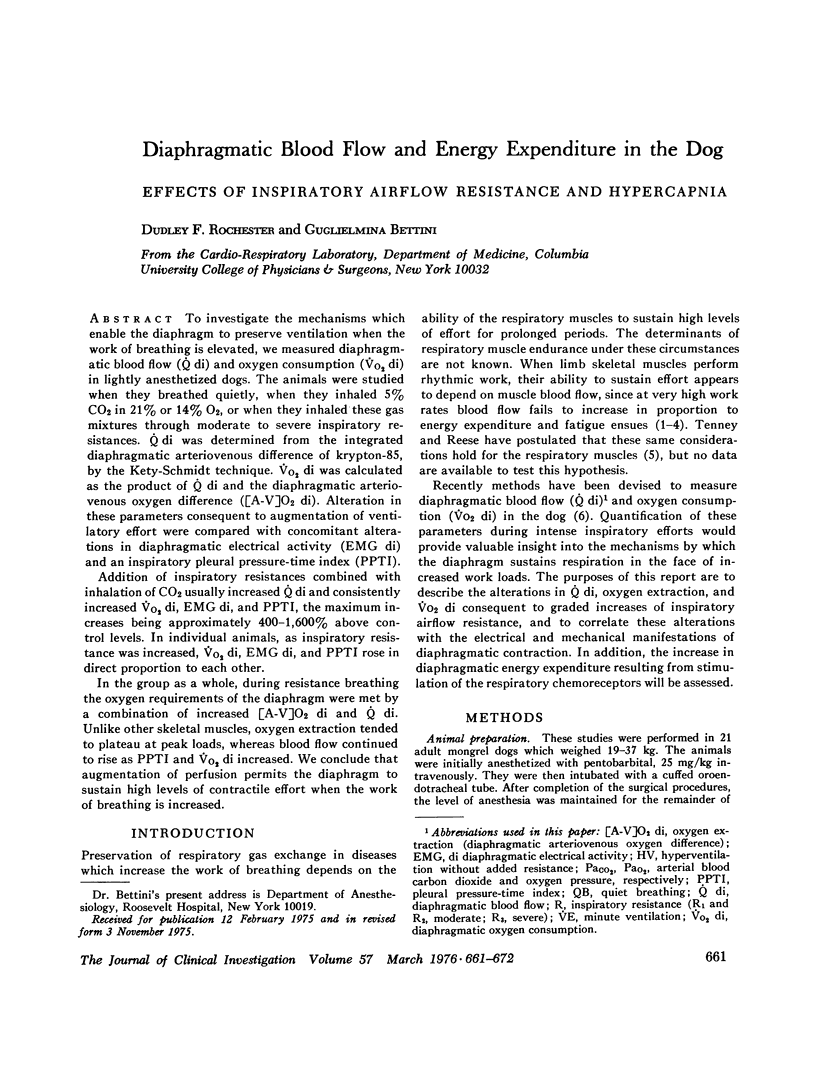
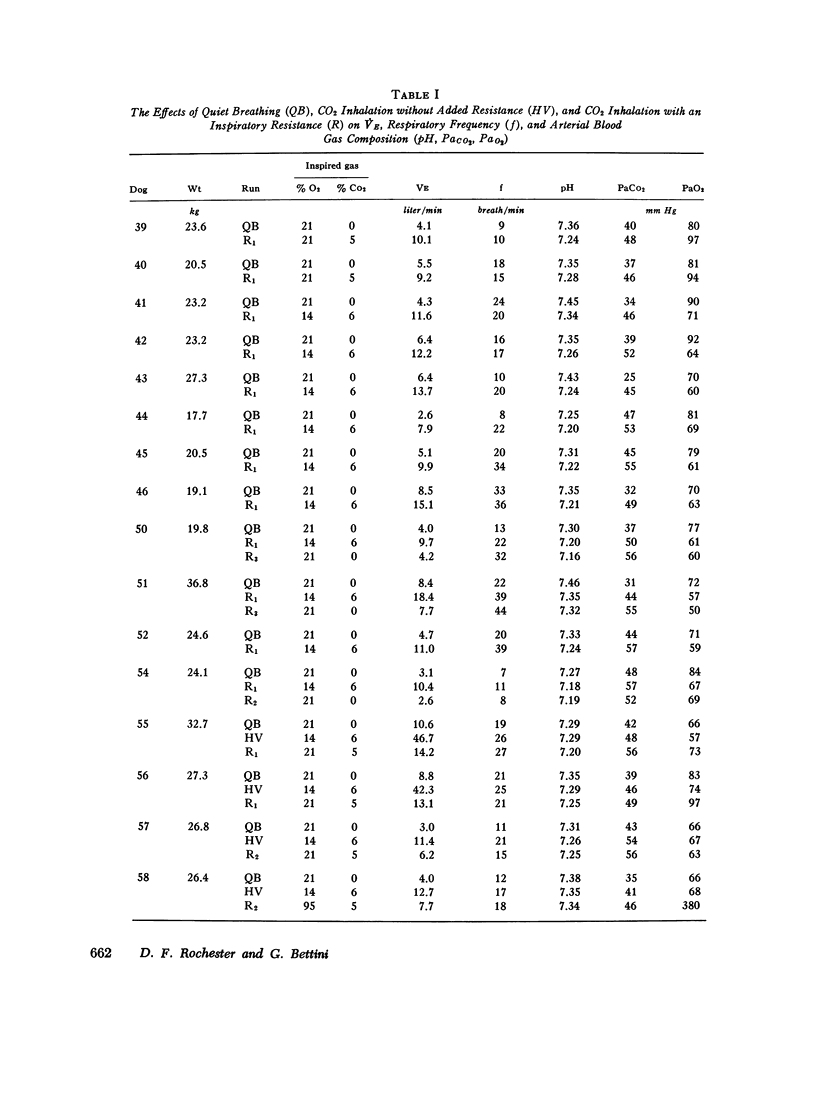
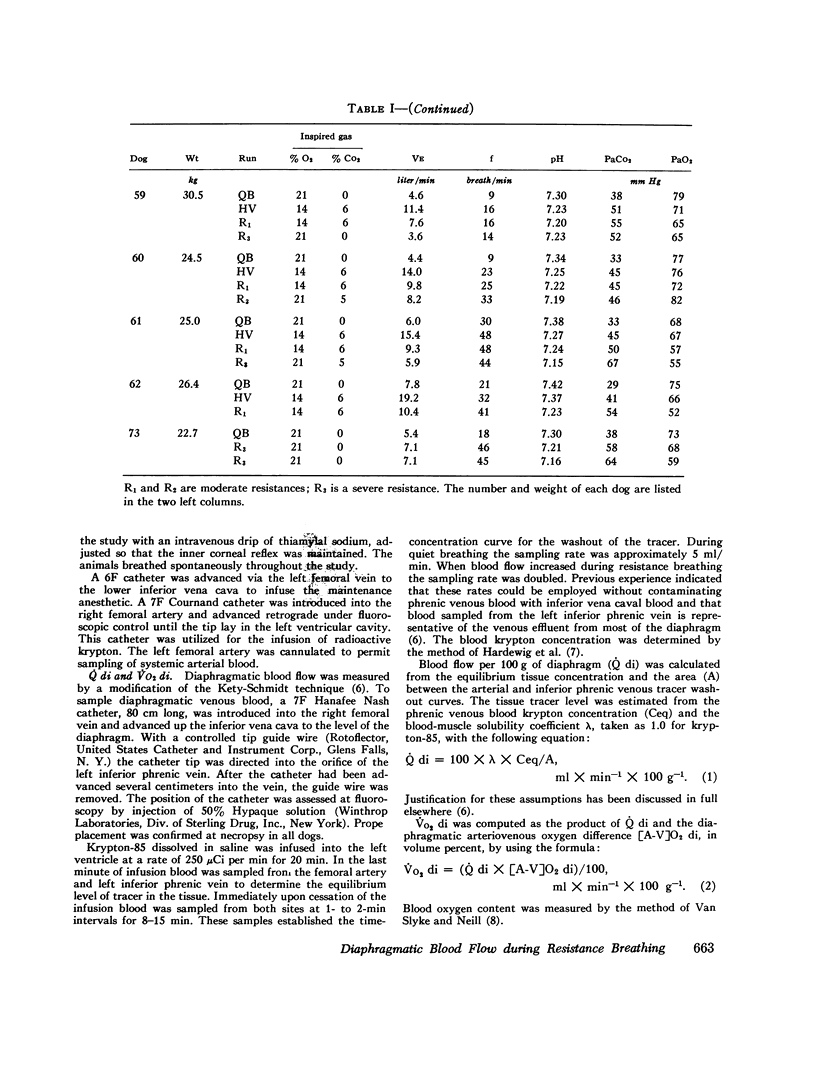
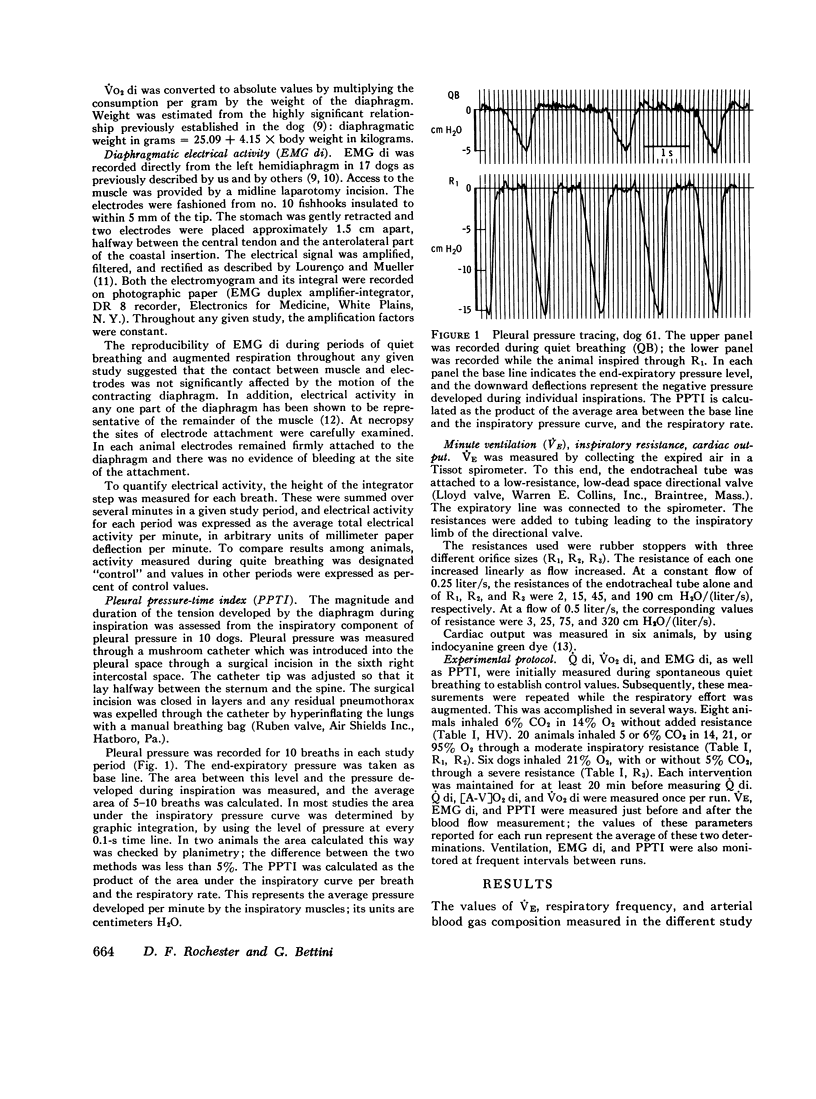
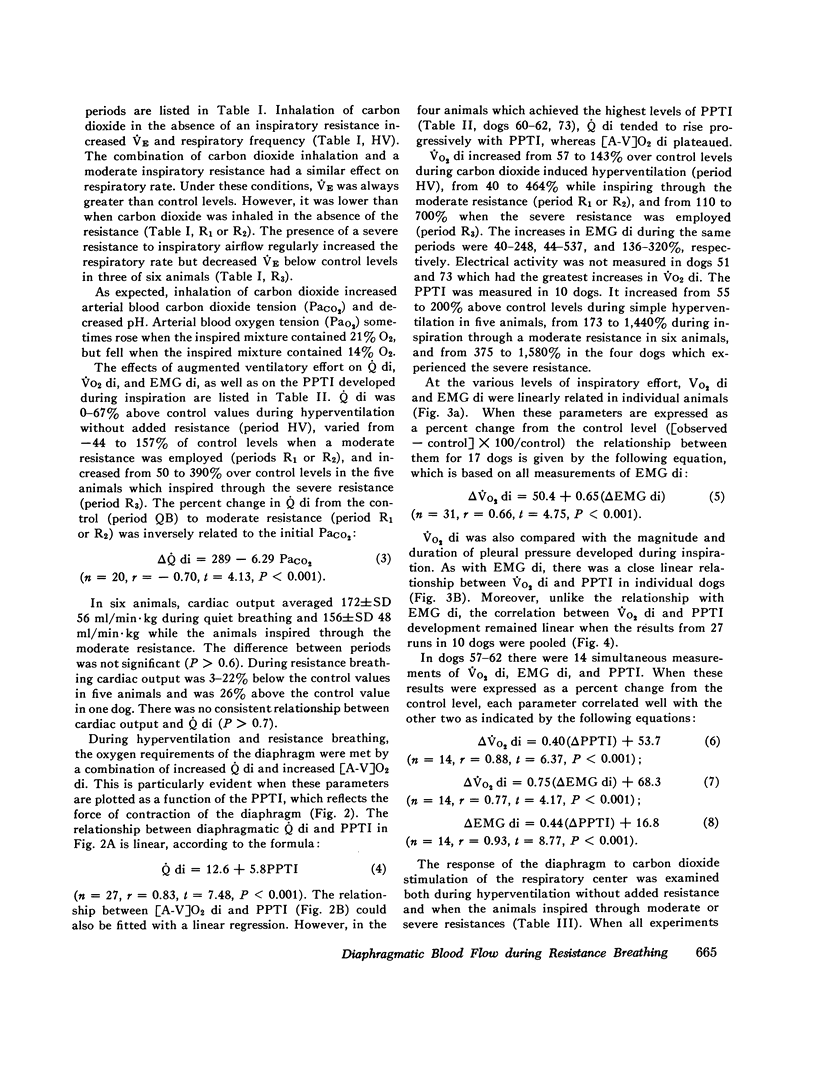
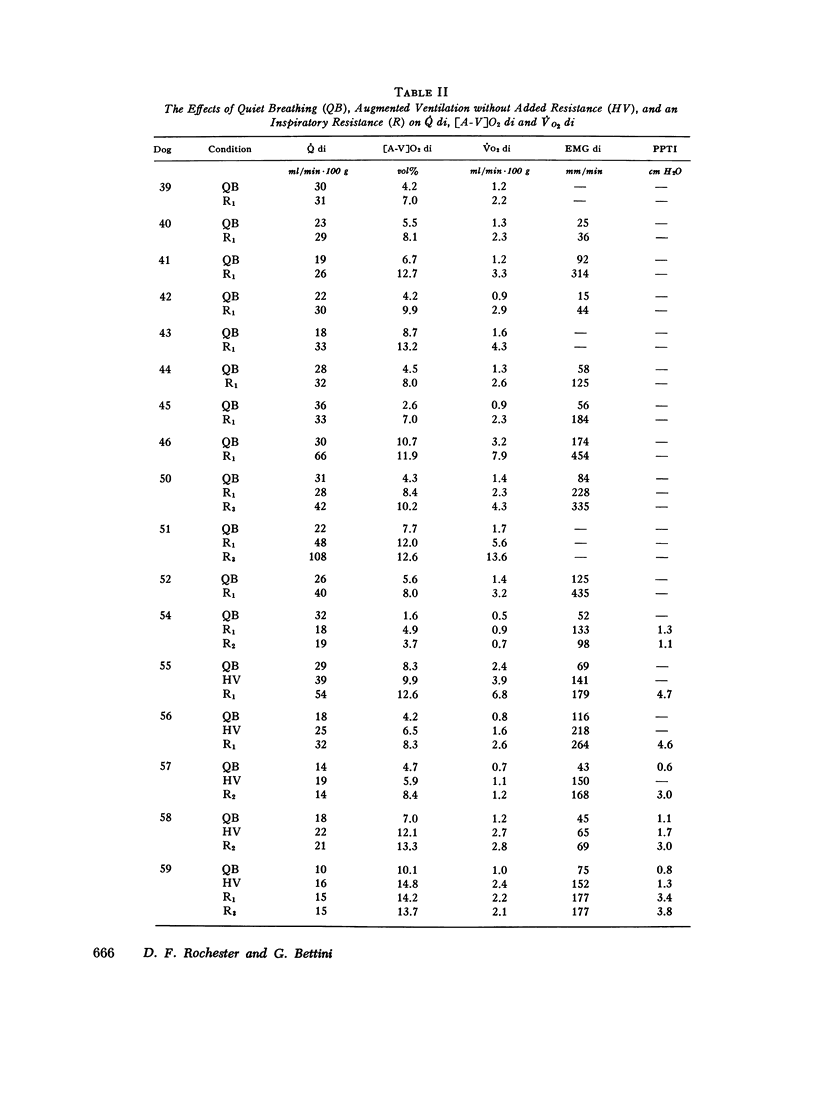
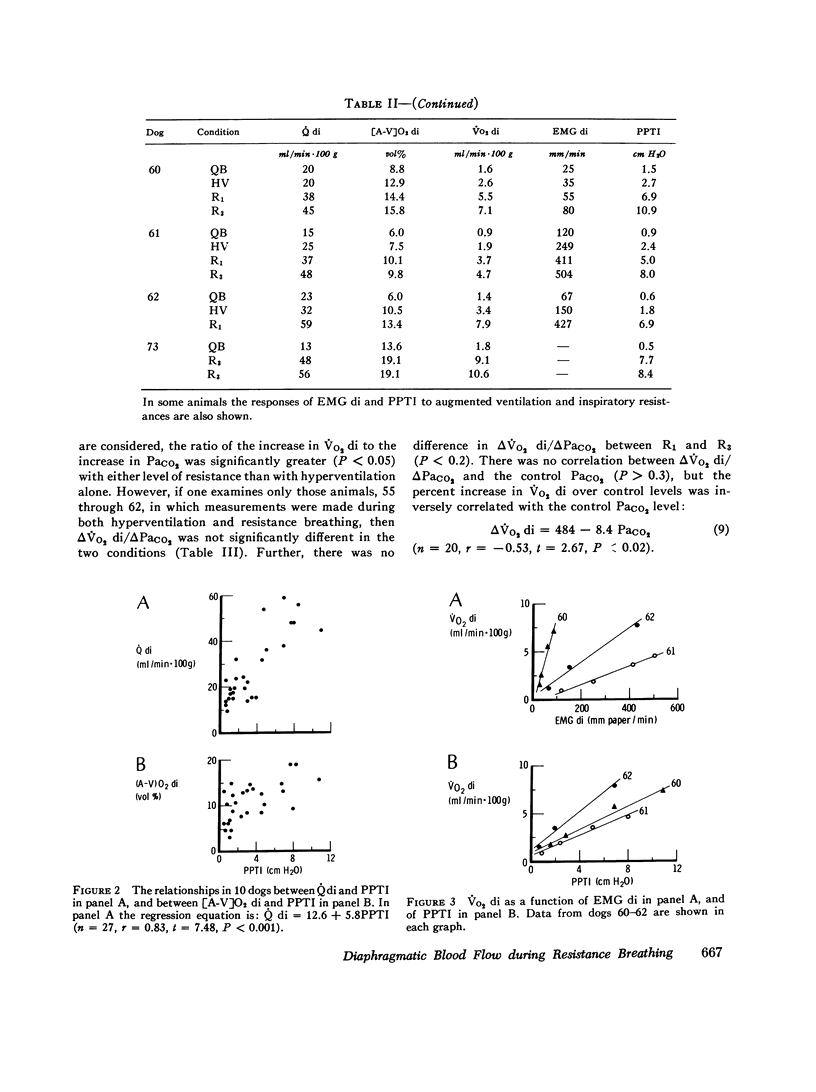
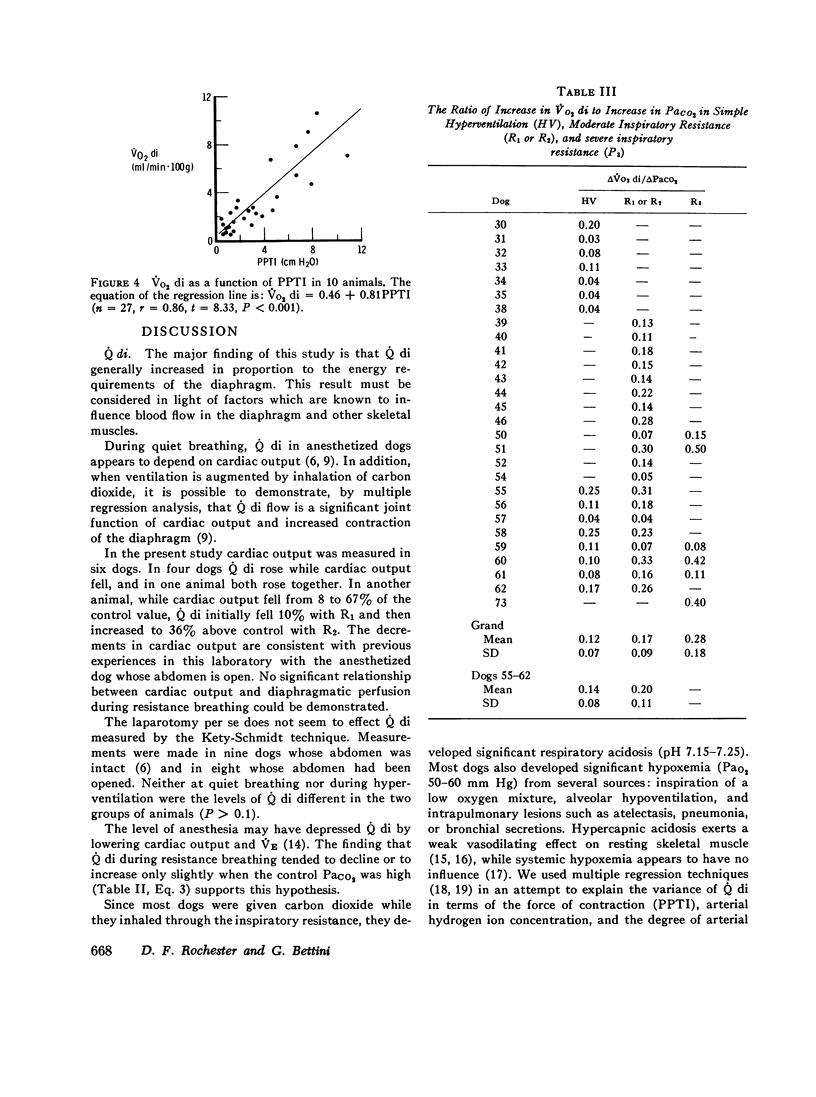
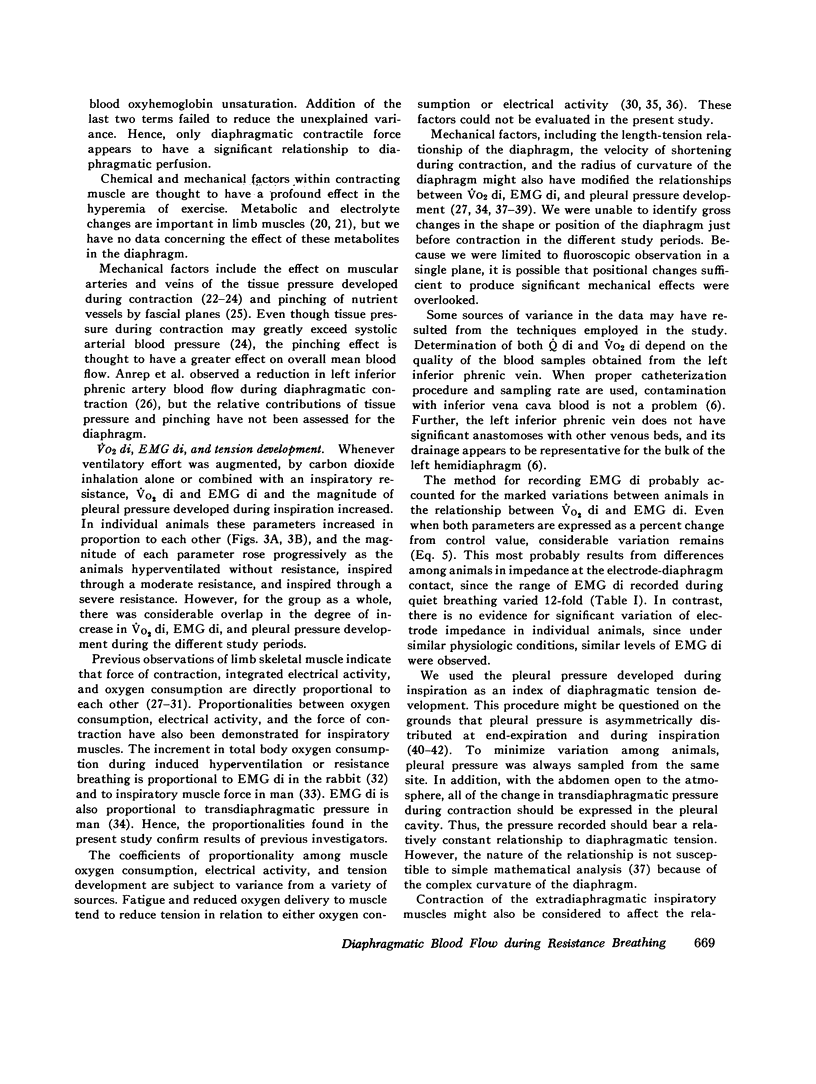
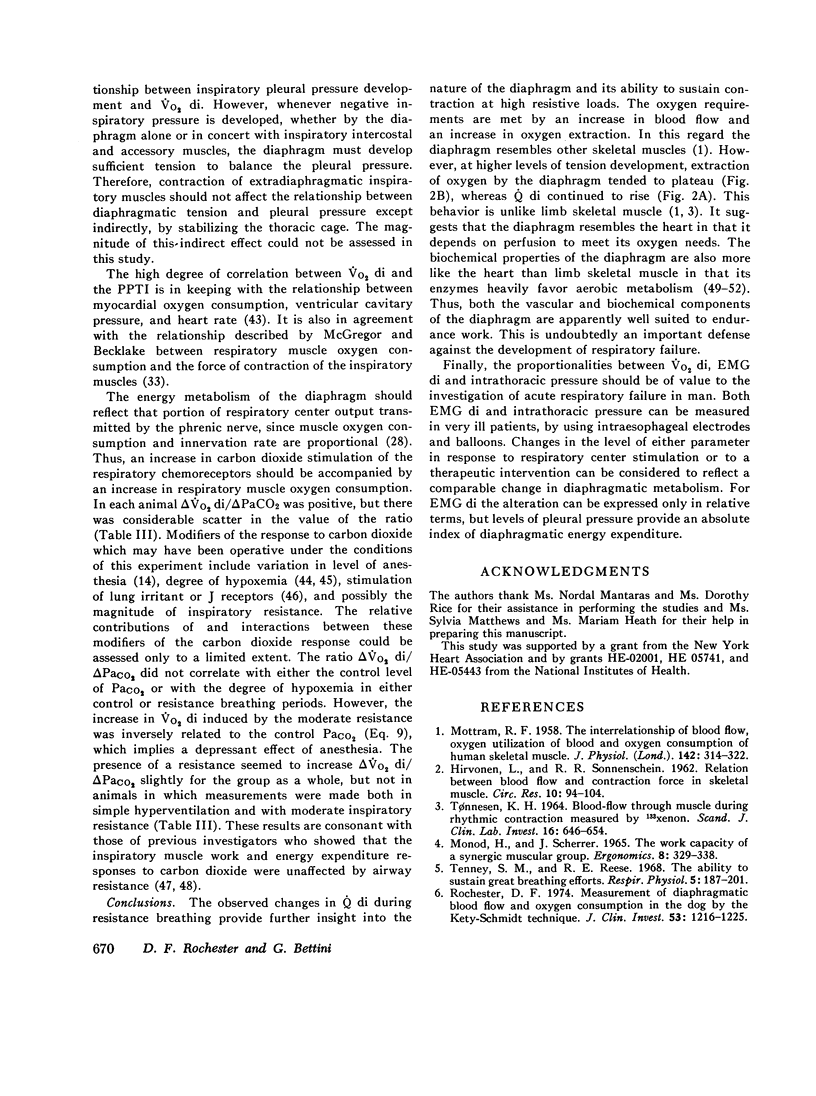

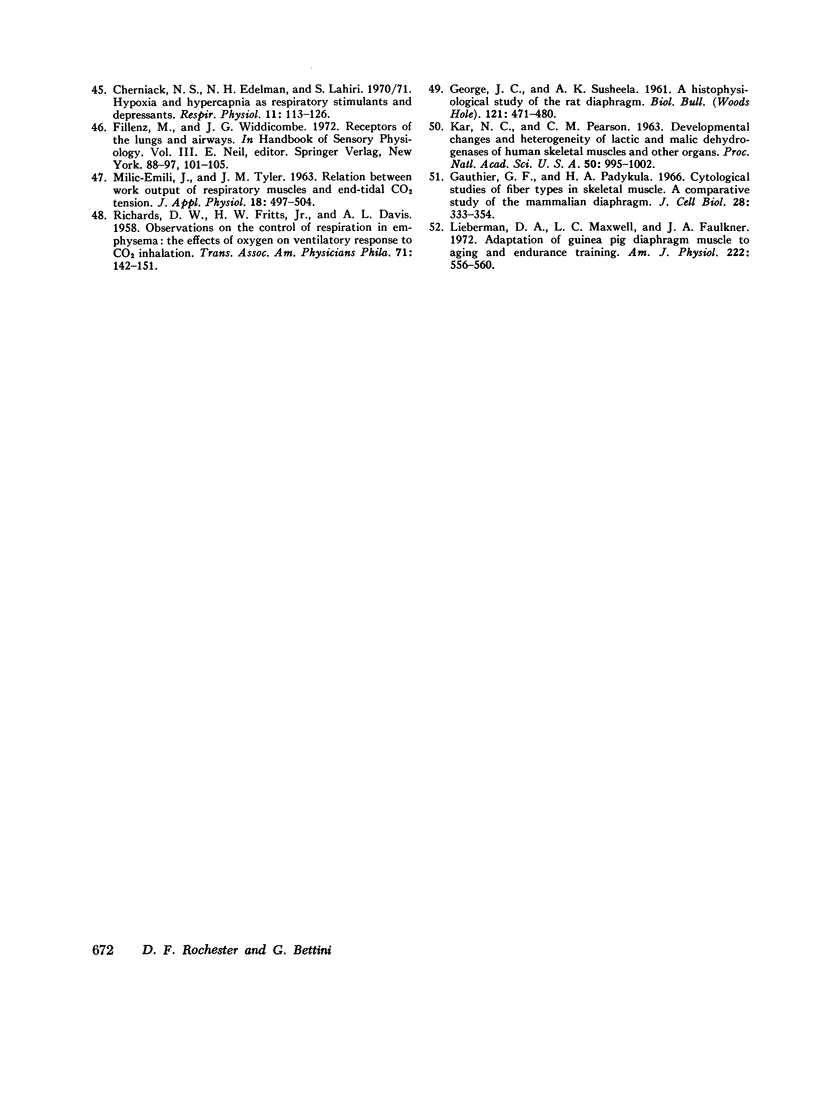
Selected References
These references are in PubMed. This may not be the complete list of references from this article.
- AGOSTONI E., SANT'AMBROGIO G., DEL PORTILLO CARRASCO H. Electromyography of the diaphragm in man and transdiaphragmatic pressure. J Appl Physiol. 1960 Nov;15:1093–1097. doi: 10.1152/jappl.1960.15.6.1093. [DOI] [PubMed] [Google Scholar]
- BIGLAND B., LIPPOLD O. C. The relation between force, velocity and integrated electrical activity in human muscles. J Physiol. 1954 Jan;123(1):214–224. doi: 10.1113/jphysiol.1954.sp005044. [DOI] [PMC free article] [PubMed] [Google Scholar]
- BOYD W. H., BASMAJIAN J. V. Electromyography of the diaphragm in rabbits. Am J Physiol. 1963 May;204:943–948. doi: 10.1152/ajplegacy.1963.204.5.943. [DOI] [PubMed] [Google Scholar]
- Banchero N., Rutishauser W. J., Tsakiris A. G., Wood E. H. Respiratory changes in pleural pressures at different sites and body positions. J Appl Physiol. 1967 Jun;22(6):1075–1080. doi: 10.1152/jappl.1967.22.6.1075. [DOI] [PubMed] [Google Scholar]
- Bigland-Ritchie B., Woods J. J. Integrated EMG and oxygen uptake during dynamic contractions of human muscles. J Appl Physiol. 1974 Apr;36(4):475–479. doi: 10.1152/jappl.1974.36.4.475. [DOI] [PubMed] [Google Scholar]
- Caldwell P. R., Echeverri U., Kilcoyne M. M., Fritts H. W., Jr Observations on a model of proliferative lung disease. II. Description of pulmonary gas exchange and comparison of Fick and dye cardiac outputs. J Clin Invest. 1970 Jul;49(7):1311–1315. doi: 10.1172/JCI106346. [DOI] [PMC free article] [PubMed] [Google Scholar]
- Cherniack N. S., Edelman N. H., Lahiri S. Hypoxia and hypercapnia as respiratory stimulants and depressants. Respir Physiol. 1970;11(1):113–126. doi: 10.1016/0034-5687(70)90107-6. [DOI] [PubMed] [Google Scholar]
- Costin J. C., Skinner N. S., Jr Effects of systemic hypoxemia on vascular resistance in dog skeletal muscle. Am J Physiol. 1970 Mar;218(3):886–893. doi: 10.1152/ajplegacy.1970.218.3.886. [DOI] [PubMed] [Google Scholar]
- D'Angelo E., Sant'Ambrogio G., Agostoni E. Effect of diaphragm activity or paralysis on distribution of pleural pressure. J Appl Physiol. 1974 Sep;37(3):311–315. doi: 10.1152/jappl.1974.37.3.311. [DOI] [PubMed] [Google Scholar]
- EDWARDS R. G., LIPPOLD O. C. The relation between force and integrated electrical activity in fatigued muscle. J Physiol. 1956 Jun 28;132(3):677–681. doi: 10.1113/jphysiol.1956.sp005558. [DOI] [PMC free article] [PubMed] [Google Scholar]
- Folkow B., Gaskell P., Waaler B. A. Blood flow through limb muscles during heavy rhythmic exercise. Acta Physiol Scand. 1970 Sep;80(1):61–72. doi: 10.1111/j.1748-1716.1970.tb04770.x. [DOI] [PubMed] [Google Scholar]
- GARCIA RAMOS J., ARJONA P. Oxygen consumption of the breathing processes. Am J Physiol. 1956 Feb;184(2):359–364. doi: 10.1152/ajplegacy.1956.184.2.359. [DOI] [PubMed] [Google Scholar]
- Gauthier G. F., Padykula H. A. Cytological studies of fiber types in skeletal muscle. A comparative study of the mammalian diaphragm. J Cell Biol. 1966 Feb;28(2):333–354. doi: 10.1083/jcb.28.2.333. [DOI] [PMC free article] [PubMed] [Google Scholar]
- Gray S. D., Carlsson E., Staub N. C. Site of increased vascular resistance during isometric muscle contraction. Am J Physiol. 1967 Sep;213(3):683–689. doi: 10.1152/ajplegacy.1967.213.3.683. [DOI] [PubMed] [Google Scholar]
- HARDEWIG A., ROCHESTER D. F., BRISCOE W. A. Measurement of solubility coefficients of krypton in water, plasma and human blood, using radioactive Kr85. J Appl Physiol. 1960 Jul;15:723–725. doi: 10.1152/jappl.1960.15.4.723. [DOI] [PubMed] [Google Scholar]
- HIRVONEN L., SONNENSCHEIN R. R. Relation between blood flow and contraction force in active skeletal muscle. Circ Res. 1962 Jan;10:94–104. doi: 10.1161/01.res.10.1.94. [DOI] [PubMed] [Google Scholar]
- Henriksson J., Bonde-Petersen F. Integrated electromyography of quadriceps femoris muscle at different exercise intensities. J Appl Physiol. 1974 Feb;36(2):218–220. doi: 10.1152/jappl.1974.36.2.218. [DOI] [PubMed] [Google Scholar]
- KAR N. C., PEARSON C. M. DEVELOPMENTAL CHANGES AND HETEROGENEITY OF LACTIC AND MALIC DEHYDROGENASES OF HUMAN SKELETAL MUSCLES AND OTHER ORGANS. Proc Natl Acad Sci U S A. 1963 Nov;50:995–1002. doi: 10.1073/pnas.50.5.995. [DOI] [PMC free article] [PubMed] [Google Scholar]
- Kontos H. A., Richardson D. W., Patterson J. L., Jr Vasodilator effect of hypercapnic acidosis on human forearm blood vessels. Am J Physiol. 1968 Dec;215(6):1403–1405. doi: 10.1152/ajplegacy.1968.215.6.1403. [DOI] [PubMed] [Google Scholar]
- Kontos H. A., Thames M. D., Lombana A., Watlington C. O., Jessee F., Jr Vasodilator effects of local hypercapnic acidosis in dog skeletal muscle. Am J Physiol. 1971 Jun;220(6):1569–1572. doi: 10.1152/ajplegacy.1971.220.6.1569. [DOI] [PubMed] [Google Scholar]
- Kuroda E., Klissouras V., Milsum J. H. Electrical and metabolic activities and fatigue in human isometric contraction. J Appl Physiol. 1970 Sep;29(3):358–367. doi: 10.1152/jappl.1970.29.3.358. [DOI] [PubMed] [Google Scholar]
- Lieberman D. A., Maxwell L. C., Faulkner J. A. Adaptation of guinea pig diaphragm muscle to aging and endurance training. Am J Physiol. 1972 Mar;222(3):556–560. doi: 10.1152/ajplegacy.1972.222.3.556. [DOI] [PubMed] [Google Scholar]
- Lourenço R. V., Mueller E. P. Quantification of electrical activity in the human diaphragm. J Appl Physiol. 1967 Mar;22(3):598–600. doi: 10.1152/jappl.1967.22.3.598. [DOI] [PubMed] [Google Scholar]
- MCGREGOR M., BECKLAKE M. R. The relationship of oxygen cost of breathing to respiratory mechanical work and respiratory force. J Clin Invest. 1961 Jun;40:971–980. doi: 10.1172/JCI104336. [DOI] [PMC free article] [PubMed] [Google Scholar]
- MOTTRAM R. F. The interrelationship of blood flow, oxygen utilization of blood and oxygen consumption of human skeletal muscle. J Physiol. 1958 Jul 14;142(2):314–322. doi: 10.1113/jphysiol.1958.sp006018. [DOI] [PMC free article] [PubMed] [Google Scholar]
- McMahon S. M., Proctor D. F., Permutt S. Pleural surface pressure in dogs. J Appl Physiol. 1969 Dec;27(6):881–885. doi: 10.1152/jappl.1969.27.6.881. [DOI] [PubMed] [Google Scholar]
- Mohrman D. E., Sparks H. V. Myogenic hyperemia following brief tetanus of canine skeletal muscle. Am J Physiol. 1974 Sep;227(3):531–535. doi: 10.1152/ajplegacy.1974.227.3.531. [DOI] [PubMed] [Google Scholar]
- Pengelly L. D., Alderson A. M., Milic-Emili J. Mechanics of the diaphragm. J Appl Physiol. 1971 Jun;30(6):797–805. doi: 10.1152/jappl.1971.30.6.797. [DOI] [PubMed] [Google Scholar]
- RAMSAY A. G. Effects of metabolism and anesthesia on pulmonary ventilation. J Appl Physiol. 1959 Jan;14(1):102–104. doi: 10.1152/jappl.1959.14.1.102. [DOI] [PubMed] [Google Scholar]
- RICHARDS D. W., FRITTS H. W., Jr, DAVIS A. L. Observations on the control of respiration in emphysema: the effects of oxygen on ventilatory response to CO2 inhalation. Trans Assoc Am Physicians. 1958;71:142–151. [PubMed] [Google Scholar]
- Rochester D. F. Measurement of diaphragmatic blood flow and oxygen consumption in the dog by the Kety-Schmidt technique. J Clin Invest. 1974 May;53(5):1216–1225. doi: 10.1172/JCI107668. [DOI] [PMC free article] [PubMed] [Google Scholar]
- Rochester D. F., Pradel-Guena M. Measurement of diaphragmatic blood flow in dogs from xenon 133 clearance. J Appl Physiol. 1973 Jan;34(1):68–74. doi: 10.1152/jappl.1973.34.1.68. [DOI] [PubMed] [Google Scholar]
- Rubio R., Berne R. M., Dobson J. G., Jr Sites of adenosine production in cardiac and skeletal muscle. Am J Physiol. 1973 Oct;225(4):938–953. doi: 10.1152/ajplegacy.1973.225.4.938. [DOI] [PubMed] [Google Scholar]
- SARNOFF S. J., BRAUNWALD E., WELCH G. H., Jr, CASE R. B., STAINSBY W. N., MACRUZ R. Hemodynamic determinants of oxygen consumption of the heart with special reference to the tension-time index. Am J Physiol. 1958 Jan;192(1):148–156. doi: 10.1152/ajplegacy.1957.192.1.148. [DOI] [PubMed] [Google Scholar]
- Stainsby W. N., Barclay J. K. Oxygen uptake for brief tetanic contractions of dog skeletal muscle in situ. Am J Physiol. 1972 Aug;223(2):371–375. doi: 10.1152/ajplegacy.1972.223.2.371. [DOI] [PubMed] [Google Scholar]
- TONNESEN K. H. BLOOD-FLOW THROUGH MUSCLE DURING RHYTHMIC CONTRACTION MEASURED BY 133-XENON. Scand J Clin Lab Invest. 1964;16:646–654. doi: 10.3109/00365516409055229. [DOI] [PubMed] [Google Scholar]
- Tenney S. M., Reese R. E. The ability to sustain great breathing efforts. Respir Physiol. 1968 Jun;5(1):187–201. doi: 10.1016/0034-5687(68)90086-8. [DOI] [PubMed] [Google Scholar]
- WILEY R. L., ZECHMAN F. W., Jr INITIAL RESPONSES TO ADDED VISCOUS RESISTANCE TO INSPIRATION IN DOGS. J Appl Physiol. 1965 Jan;20:160–163. doi: 10.1152/jappl.1965.20.1.160. [DOI] [PubMed] [Google Scholar]
- Wright D. L., Sonnenschein R. R. Muscle force and electromyogram with alteration in flow and composition of blood. Am J Physiol. 1969 May;216(5):1075–1080. doi: 10.1152/ajplegacy.1969.216.5.1075. [DOI] [PubMed] [Google Scholar]


